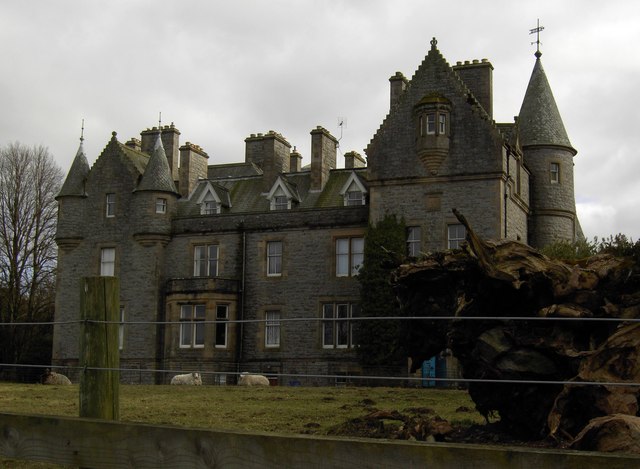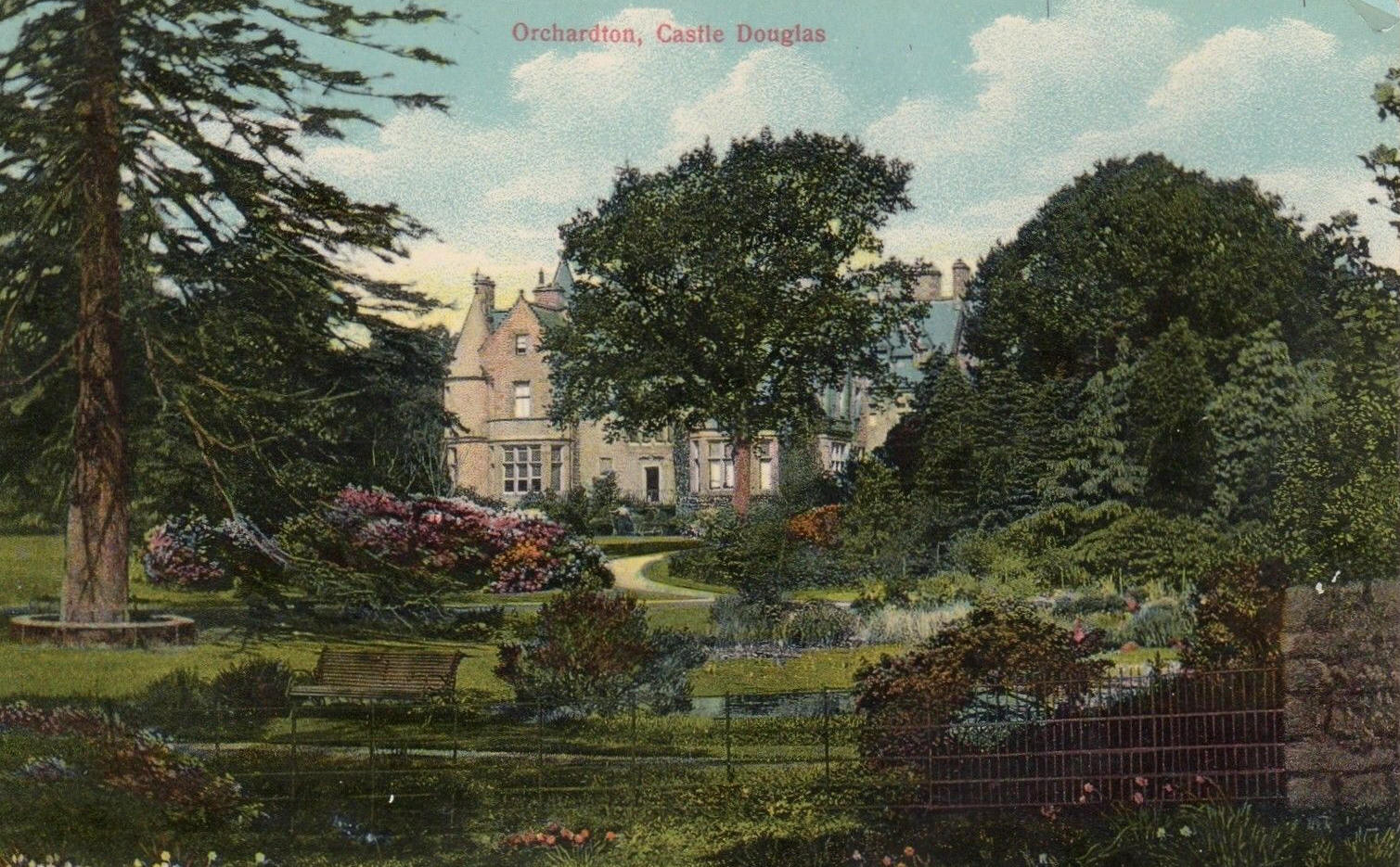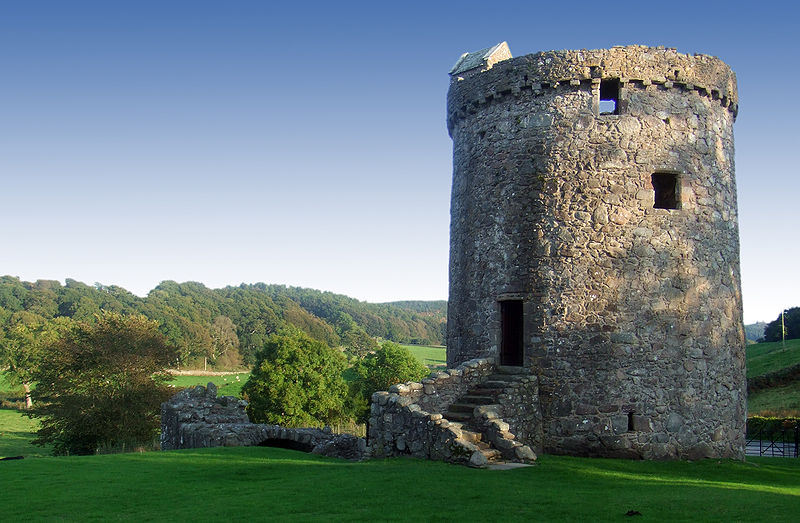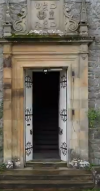Orchardton Tower, Castle and estate
This large barony lies in the Stewartry of Kirkcudbright south of
Palnackie. Originally owned by the Cairns family, it centers on the
unique round tower house of the same name. It came into the
possession of Maxwell family of Drumcoltran in the middle of the
sixteenth century through marriage. Edward Maxwell of Drumcoltran
sold Orchardton to Robert Maxwell of Spottes, grandson of John
Maxwell, Lord Herries in 1640. There after this family were created
Baronets with the designation of Orchardton. They built a new tower
house and mansion some quarter mile south of the old tower at a
former farm named Glenshinnoch which they renamed Orchardton House.
The Maxwells of Orchardton split off a portion of the barony in the
south west to form the lesser barony of
Gelston which became the estate of a younger son. Orcharton was
the home of Sir Robert Maxwell who was out in the '45' with Bonnie
Prince Charlie and was immortalized in Sir Walter Scott's Guy
Mannering.
The Maxwells continued to live at Orchardton until the 7th Baronet
started work on a new mansion two miles away in 1765. The costs
bankrupted him and in 1785 he sold his estate, including Orchardton
Tower, to James Douglas,
'a Liverpool merchant'. He styled himself 'of Orchardton'. (Some
sources say he bought it from the Bank of Scotland). Maxwell
had also become involved in the failed
Douglas, Heron & Co Bank,
which resulted in a spate of bankruptcies.
Following his death, his estates were divided amongst his three
daughters. The youngest who received the Orchardton barony was
married to Colonel Christopher Maxwell, a younger son of the
Maxwells of Cardoness. There were no children surviving from this
union and the barony passed out of Maxwell hands upon Mrs Maxwell
death.
In 1878 his successor William Robinson-Douglas demolished and
rebuilt the mansion that had been started in 1765.

 Orchardton
Castle, previously known by the names of "Orchardton House" & "Orchardton
Hall", is a magnificent Scottish Baronial Mansion of significant
architectural importance and is situated 1.5 miles from Auchencairn
and about 7 miles to Castle Douglas. The house has an interesting
history and has had a variety of uses since it was first built in
the 18th century.
Orchardton
Castle, previously known by the names of "Orchardton House" & "Orchardton
Hall", is a magnificent Scottish Baronial Mansion of significant
architectural importance and is situated 1.5 miles from Auchencairn
and about 7 miles to Castle Douglas. The house has an interesting
history and has had a variety of uses since it was first built in
the 18th century.
Since 2003 Orchardton has been put back to single occupation
and has been much improved and modernised including a new kitchen,
advanced central heating systems and extensive roof repairs.
Internally there are some fifty rooms with large impressive hallways
and staircases, ornate ceilings, imposing fireplaces and panelling.
There are uninterrupted views over Orchardton Bay and across
the Solway to the Lakeland Fells and the area is well known for its
beautiful coastline, scenery, sandy beaches and bustling towns
nearby and the county enjoys a mild climate. Dumfries is about 20
miles, Edinburgh around 96 miles, Glasgow about 90 miles and
Prestwick about 63 miles.
Completed in Scottish baronial
style by William Douglas Robinson in the 1880’s, on the site of a
small mansion dating from around 1761. Originally built by Sir
Robert Maxwell, seventh baronet of Orchardton, who married a
McLellan of Kirkudbright castle, and used the roof timbers and stone
from Orchardton castle, (now just Orchardton tower remaining)
rebuilding it in a better location. In 1786 the estate came into the
ownership of James
Douglas, the brother of
William Douglas, founder of Castle Douglas. Part of the original
wall structure is still evident.
It has impressive
asymetrical elevations which incorporate large bay windows, crowstep
gables, corbelled turrets and tall chimney stacks. The property has
beautiful original features including oak panelling, impressive
stairways with carved balustrades and imposing open fireplaces, many
with carved mantels and original tiling. To the side there is an
enclosed courtyard and a separate stable with power and water to
accommodate 2 horses.
There are some 40 rooms as well as
store rooms, a walk in linen cupboard and impressive hallways. Most
rooms and hallways have original wooden shutters. There is even a
manual pulley on one of the two sets of full height staircases.
The house has
had an interesting history, and was used during the second world war
as a military convalescent hospital for wounded officers, after the
war the house was let and run as a hotel. The whole Estate,
extending to 1767 acres was sold in 1951 and the purchaser of
Orchardton House continued to run it as a hotel until 1960 when it
became a school, when the school closed in 1981, it was then run as
a house for residential courses and conferences and later housed a
community of artists and craftspeople until being sold again in
2003.
 Orchardton
Tower is remarkable as the only round tower house in Scotland.
Orchardton
Tower is remarkable as the only round tower house in Scotland.
The Cairns family, who built Orchardton, were associated with
the area from the early 15th century. Alexander Cairns was Provost
of Lincluden, now an area of Dumfries, until his death in 1422. His
brother, John Cairns, was Custumar, or customs officer, in
Linlithgow. John Cairns was also a military engineer, and was
responsible for designing the impressive King David's Tower at
Edinburgh Castle, which was destroyed in 1573. His heir, another
John Cairns who was his nephew's son, was granted the lands of 'Irisbuitle',
or Orchardton, in 1456. The grant of former Douglas lands was
possibly in return for Cairns' support for James II, in his
successful struggle to overthrow the power of the 'Black' Earls of
Douglas. John Cairns built Orchardton Tower soon after. The fact
that round towers are common in Ireland has led to speculation of
Irish influence at Orchardton. However, no specific link has been
found.
John Cairns' grandson William was present, in support
of his relatives Agnew and Lochinvar, at the murder of Thomas
McLellan of Bombie, outside St. Giles' Cathedral, Edinburgh in 1527.
On William's death in 1558 the estate was partitioned between his
three daughters. The part including the castle was sold in 1616 to
Robert Maxwell, who had earlier bought the other portions of the
estate. Maxwell was a nephew of Lord Maxwell, and in 1663 was
created a baronet.
Maxwell's descendants were divided along with the rest of the
country during the Reformation. Mungo Maxwell (b. 1700) was
illegally disinherited by his half brothers on religious grounds.
His son, another Robert Maxwell, was raised in France, and obtained
a commission in the French Army. Following service in France, he
took part in the second Jacobite Rising in 1745. He was wounded at
Culloden and taken prisoner, where his commission was discovered and
he was consequently spared execution; as a foreign soldier, he was
treated as a prisoner of war rather than a traitor.
Robert
returned to France for a time, before deciding to declare himself a
Protestant in order to claim his rightful inheritance. In 1753 he
resigned his commission and returned to Scotland to begin a long
lawsuit, which ended in 1771 when he was confirmed as Sir Robert
Maxwell, 7th Bt. These events were used as inspiration by Sir Walter
Scott, for his novel Guy Mannering.
Robert Maxwell completed
construction of a new, more comfortable residence at Orchardton
House. He was bankrupted by his financial dealings, and in 1785 the
estate was sold to the Douglas family. It is unlikely that the
castle was lived in after this time.
The round tower was
located at the north east corner of a fortified yard or barmkin,
which would have sheltered livestock and provided cellars, a
bakehouse, and probably a hall built on an upper level. The tower
itself was reserved for living quarters, and was accessed via a
stair, possibly moveable, from the barmkin up to a first floor
doorway. The present entrance, on the north of the tower, was
constructed in the 17th or 18th centuries. A new door was formed
from a window and a permanent stone stair constructed.
The
tower is 11m, in height, and around 9m in diameter, tapering
slightly to the top. A corbelled parapet forms the top of the walls,
with a gabled caphouse covering the spiral stair, which is within
the 1.8m thick wall. Inside, a vaulted cellar occupies the ground
floor. Above this was a main room with fireplace, deep windows with
seats, and a carved lavabo or piscina. Above this would have been
two further rooms, although the wooden floors have collapsed.
Orchardton Tower is now in the care of Historic Scotland, and is a
Scheduled Ancient Monument.
 |
 |
 |
 |
 |
Lintel plaque on Orchardton House
The initials WDRD
over door are those of William Douglas Robinson-Douglas,
b1851, d1921. He succeeded to Orchardton 1878. (The panel
1881 records the date of his additions to the house.) |
Main entrance |
Crest on an internal window |
Portrait of James Douglas |
Heart ceiling |
Note:
1. As of September 2016, Orchardton Castle is on the
market at offers over £2 million. In Janaury 2022, Orchardton
is again on the market 'through no fault of its own'. Offers
over £1.7 million are sought.
Any contributions will be
gratefully accepted
Errors and Omissions
|
|
The Forum
|
|
What's new?
|
|
We are looking for your help to improve the accuracy of The Douglas
Archives.
If you spot errors, or omissions, then
please do let us know
Contributions
Many articles are stubs which would benefit from re-writing.
Can you help?
Copyright
You are not authorized to add this page or any images from this page
to Ancestry.com (or its subsidiaries) or other fee-paying sites
without our express permission and then, if given, only by including
our copyright and a URL link to the web site.
|
|
If you have met a brick wall
with your research, then posting a notice in the Douglas Archives
Forum may be the answer. Or, it may help you find the answer!
You may also be able to help others answer their queries.
Visit the
Douglas Archives Forum.
2 Minute Survey
To provide feedback on the website, please take a couple of
minutes to complete our
survey.
|
|
We try to keep everyone up to date with new entries, via our
What's New section on the
home page.
We also use
the Community
Network to keep researchers abreast of developments in the
Douglas Archives.
Help with costs
Maintaining the three sections of the site has its costs. Any
contribution the defray them is very welcome
Donate
Newsletter
If you would like to receive a very occasional newsletter -
Sign up!
|
|
|
|
|
|
|
|


